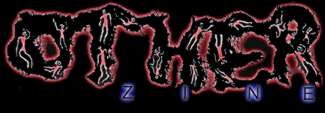
Animal Charm: Channel Surfing from the Plunderground
reprinted from Select Magazine (www.select-media.com)
(Click here for printer-friendly version)
Massive corporate mergers like the one between Time Warner and AOL are changing the genetic code of mass media and the world we are living in. Information is as important a commodity as gold was in the pioneer days of the American West. Today, electronic borders take social and political precedence over geographic boundaries as e-commerce builds international empires virtually free from public and private laws as witnessed by Microsoft's current monopolization of the digital age and their near legal immunity in executing such frightening dominance.
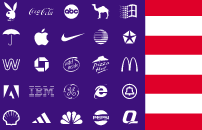 Global
intellectual property laws are perpetually
changing daily to keep up with the
speed of digital technologies in order
to insure as few mutations occur without
the excessive transaction of capital
that supercedes most individuals'
personal means. Hybrid service industry
monsters are popping up everywhere
in strip malls across America. Fast
food restaurants are morphing according
to whether they are in proprietary
alliance with Coca Cola or Pepsi.
Taco Bell/Pizza Huts, KFC/Burger Kings,
and Dunkin Donut/ Baskin Robbins are
big business examples of this recombinant
corporate process. As individuals
rights and choices get lost in the
smoke and mirrors of "free enterprise,"
new sounds and images must be created
at a mind numbing rate to uphold the
illusion of late capitalism's operatic
notion of survival of the fittest.
Global
intellectual property laws are perpetually
changing daily to keep up with the
speed of digital technologies in order
to insure as few mutations occur without
the excessive transaction of capital
that supercedes most individuals'
personal means. Hybrid service industry
monsters are popping up everywhere
in strip malls across America. Fast
food restaurants are morphing according
to whether they are in proprietary
alliance with Coca Cola or Pepsi.
Taco Bell/Pizza Huts, KFC/Burger Kings,
and Dunkin Donut/ Baskin Robbins are
big business examples of this recombinant
corporate process. As individuals
rights and choices get lost in the
smoke and mirrors of "free enterprise,"
new sounds and images must be created
at a mind numbing rate to uphold the
illusion of late capitalism's operatic
notion of survival of the fittest.
The legality of who can use what information where, combined with hyper-trade marking, patenting and copyrighting has led to digging a paradoxical cemetery of living dead icons and ideas that can only be brought back to life and accessed freely if one is willing and able to pay the exorbitant price. In our western society, where the firewall of our Tower of Alexandria is money, it is hard not to clearly see the relationship between class and cultural production. Without getting academic or theoretical, one can imagine the legal inverse of what currently surrounds intellectual property as commodity. What if it was illegal, no matter how much money one had, to create any new sounds or images, or for that matter, any new ideas or information? How would this redefine political, social, cultural and economic progress? This hypothetical situation was the breeding ground for Animal Charm, a collaborative project of Rich Bott and Jim Fetterley, that has been asking these questions by pushing the boundaries of collage aesthetics, politics, and performances since 1996.
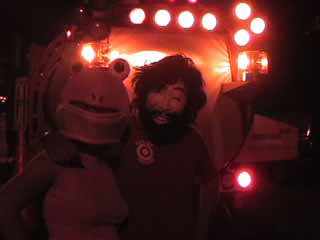 Initially
born out of an economic necessity
to create and distribute oppositional
media free from the restraints of
the marketplace, Animal Charm has
grown into a nomadic autonomous off-broadcast
channel of absurdist deconstruction
and video remix anarchy. Recombinant
single channel videotapes are prepared
from the cemetery of the mass media
machine in the midnight shifts of
edit suites wherever they can get
access to equipment. These tapes are
then presented live in front of an
audience in a four-channel performance
reanimating the dead. Animal Charm
takes this Frankenstenian Home Entertainment
system on the road inviting audiences
to bring their own experiences and
videotapes to contribute to the mix
and participate in the spell casting.
Initially
born out of an economic necessity
to create and distribute oppositional
media free from the restraints of
the marketplace, Animal Charm has
grown into a nomadic autonomous off-broadcast
channel of absurdist deconstruction
and video remix anarchy. Recombinant
single channel videotapes are prepared
from the cemetery of the mass media
machine in the midnight shifts of
edit suites wherever they can get
access to equipment. These tapes are
then presented live in front of an
audience in a four-channel performance
reanimating the dead. Animal Charm
takes this Frankenstenian Home Entertainment
system on the road inviting audiences
to bring their own experiences and
videotapes to contribute to the mix
and participate in the spell casting.
With a mission to create a critical dialog and cultural exchange surrounding these timely issues with a variety of audiences, Animal Charm have been channel surfing from the plunderground into international private and public spaces. Single channel videotapes, performances and workshops have gone from VHS self-distribution through videotape trading networks to museums and galleries, media art centers and micro cinemas, film and video festivals, public libraries and private parties, high schools and universities, bars and clubs, to just about any place that will host them. Assuming a de-constructive take on propriety,
Animal Charm began creating videos as an act of Electronic Civil Disobedience as discussed in the Critical Art Ensemble's "Electronic Disturbance." Drawing upon situationist strategies of detournement, these videotapes were then self-distributed on VHS and inserted into a variety of social and cultural contexts under the old addage, "If you throw enough punches you're bound to land one!"
Responding to Craig Baldwin's, "Sonic Outlaws," whose problematic subjects raised a number of questions, Animal Charm sought to proactively enter a dialog with communities surrounding cultural production from recycled media. Proving that necessity is the mother of invention, this self-dissemination led to exchanges with other D.I.Y. video tape producers and distributors ranging from the prolific VHS label, Peripheral Produce to the more well-established, yet equally political, Video Data Bank and their European counterpart, The Lux Centre for the Digital Arts.
As the audiences for these tapes grew, Animal Charm found that they had no accountability to all the various ways the videos were programmed. They wanted to provide a site-specific context and take responsibility for their programming, so in the fall of 1998, with Peripheral Produce, they booked their own screening tour from Vancouver to Los Angeles. Dubbed, Capricorn 1000 (or CAP1K) as a play on Y2K and the conspiracy film "Capricorn 1" hyperbolized times one thousand, this tour provided a presentation that increased the cultural exchanges they had built upon with their videos self-distributed on VHS.
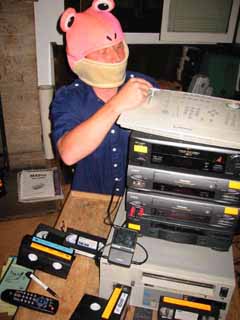 Being
present and discussing the videos
which are not expository collage essays
allowed for personal and performative
contexts to meld the presentations
with the cultural products they were
exchanging. For this tour, a consumer
grade 4 channel audio and video switcher
was purchased to seamlessly play one
video after another in a different
order each night depending on the
venue. In each town, Animal Charm
would scour local thrift stores, garage
sales and late night television broadcasts
in search of sounds and images to
add local flavor in between the precompiled
videos they were screening. This wet
their appetite for variety and always
brought the house down when a local
cable commercial would pop up in the
middle of their presentation.
Being
present and discussing the videos
which are not expository collage essays
allowed for personal and performative
contexts to meld the presentations
with the cultural products they were
exchanging. For this tour, a consumer
grade 4 channel audio and video switcher
was purchased to seamlessly play one
video after another in a different
order each night depending on the
venue. In each town, Animal Charm
would scour local thrift stores, garage
sales and late night television broadcasts
in search of sounds and images to
add local flavor in between the precompiled
videos they were screening. This wet
their appetite for variety and always
brought the house down when a local
cable commercial would pop up in the
middle of their presentation.
Hungry for more spontaneity, they found themselves playing the images of their remixes with the audio from the newly found videos based upon the mixing capabilities of the 4 channel switcher. Soon after, Animal Charm was switching between the sounds AND images from their 4 VCRs, essentially channel surfing prepared materials in front of the audience. Editing live for their performances was analogous to the type of improvisation they would do in the studio to discover unpredictable incongruities in the materials they had scavenged, plus brought about new elements of random chance operations they would never have imagined without the anxiety of re-assembling the materials on the spot. By the end of CAP1K, Animal Charm branded a unique style of multi-channel video mixing just as DJs would produce vinyl to perform with on turntables.
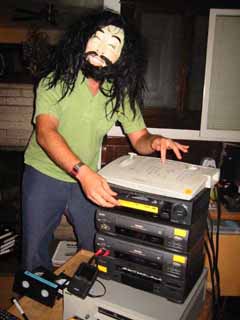 Unlike
DJs, who covet their source materials
and techniques in a highly competitive
battle of egos and commerce, Animal
Charm chose to incorporate a how-to
approach to their cabaret style shows,
increasing awareness and providing
a forum for politicizing the challenging
form and content of a variety of media
collage practices. This technique
has been honed by Animal Charm and
now their performances include workshops
sharing and demystifying the process
and equipment, encouraging audience
participation in operating the gear,
and bringing their own source audio
and video materials to rip apart and
trade with other like-minded individuals.
As a hybrid of alternative media literacy,
these performances mimic corporate
strategies of leveling the playing
field to engage, entertain, and promote
cultural exchanges that blur the lines
between the audience and the performers,
always asserting that creating autonomous
media is as easy as using your remote
control and VCR to record and recombine
television as personal expression.
Unlike
DJs, who covet their source materials
and techniques in a highly competitive
battle of egos and commerce, Animal
Charm chose to incorporate a how-to
approach to their cabaret style shows,
increasing awareness and providing
a forum for politicizing the challenging
form and content of a variety of media
collage practices. This technique
has been honed by Animal Charm and
now their performances include workshops
sharing and demystifying the process
and equipment, encouraging audience
participation in operating the gear,
and bringing their own source audio
and video materials to rip apart and
trade with other like-minded individuals.
As a hybrid of alternative media literacy,
these performances mimic corporate
strategies of leveling the playing
field to engage, entertain, and promote
cultural exchanges that blur the lines
between the audience and the performers,
always asserting that creating autonomous
media is as easy as using your remote
control and VCR to record and recombine
television as personal expression.